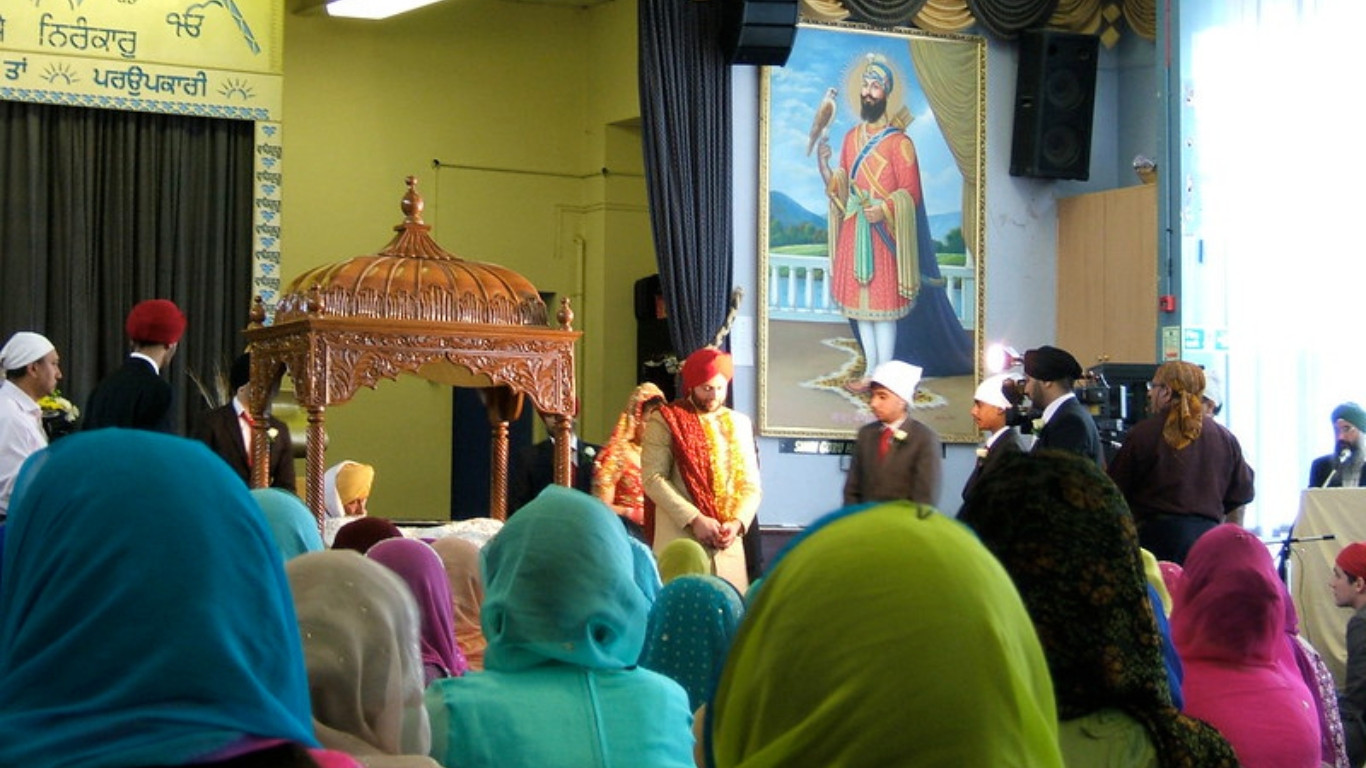
Anand Karaj: The Sikh Wedding Ceremony
The Sikh Anand Karaj holds immense importance within the Sikh community, representing the union of two souls in holy matrimony. Anand Karaj, meaning "Blissful Union". Anand Karaj is a religious ceremony and not a Punjabi cultural ceremony, as some seem to think. The core of Anand Karaj is 'Lavaan' where the tails are chanted and both husband and wife complete the 'Pakarimaa' (circulations) around Guru Granth Sahib Ji. The purpose of the ceremony is to give Sikhs the basic principles of unity with God and successful marriage.

History
Anand Karaj (or
Anand Sanskar) is a Sikh initiation ceremony introduced by Sri Guru Amar Das
Ji. The four laavans (wedding chants performed during the wedding ceremony)
were composed by his successor, Sri Guru Ram Das Ji. Anand Karaji is guided by
the Sikh Code of Conduct and Conventions (Sikh Reht Maryada) issued by the
Shiromani Gurdwara Prabandhak Committee (SGPC). Sri Akal Takht Sahib has given
a ruling through Hukumnama that Anand Karaj can only be performed in a
gurdwara.
Rituals
and ceremonies
● Milni:
Anand Karaj ceremony begins with Milni, a joyous gathering of the families of
the bride and groom. This tradition promotes unity and harmony when both
families come to celebrate the union.
● Ardaas:
Before proceeding with the marriage ceremony, ardas (prayer) is performed
seeking the blessings of the Almighty for a successful and happy marriage.
● Laavan:
The core of Anand Karaji revolves around the recitation of the four Laavans
(hymns) of the Guru Granth Sahib, the scripture of Sikhism. Each Laav
represents a different stage in the couple's spiritual journey, emphasizing
their commitment to walk the path of righteousness together.
● Kara Parshad: Throughout
Anand Karaj, Kara Parshad, a holy offering made of equal parts of wheat flour,
sugar and Indian gas, is distributed to the congregation as a symbol of unity
and equality.
● Anand Sahib:
After the Laavan is recited, the Anand Sahib hymn of happiness is sung to
celebrate the divine union of the couple. This hymn captures the joy and
gladness felt during this sacred ceremony.
● Blessings and Promises:
The couple seeks blessings from Guru Granth Sahib, their family and Sangat
(congregation). They exchange vows and promise to support and love each other
throughout their marriage.
● Karah Prasad and Langar:
The ceremony ends with the distribution of the blessed sweet pudding Karah
Prasad and the consumption of Langar, a communal meal. These practices promote
humility, equality and a spirit of service in the Sikh community.
Cultural
Significance and Contemporary Relevance
Equality
and Inclusivity
The Sikh Anand
Karaj exemplifies the egalitarian principles deeply rooted in Sikhism.
Regardless of caste, creed, or social status, all individuals are welcome to
participate in and witness the wedding ceremony. This inclusivity and emphasis
on equality continue to resonate with Sikhs around the world, making the Anand
Karaj a truly universal celebration of love.
Sanctity
of Marriage
Sikh Anand Karaj
emphasizes the sacredness of the institution of marriage, encouraging couples
to build a spiritual bond founded on mutual respect, love, and shared values.
The ceremony serves as a reminder of the commitment required to nurture a
lifelong partnership based on the teachings of Sikh Gurus.
Symbolism
and Spirituality
The Anand Karaj
draws upon rich symbolism to convey profound spiritual messages. The recitation
of the Laavan signifies the stages of union with the divine, reflecting the
couple's journey towards spiritual enlightenment and self-realization. Each
ritual and hymn holds deep meaning, fostering a sense of spiritual connection
within the couple and the congregation.
Conclusion
The Sikh Anand
Karaj epitomizes Sikhism's principles and teachings, emphasizing the importance
of love, equality, and spirituality within the institution of marriage. This
detailed guide intends to provide you with a thorough understanding of the
Anand Karaj's ceremonies, traditions, and cultural significance. May this
information inspire you to respect and treasure the beauty and sacredness of
Sikh marriages.
